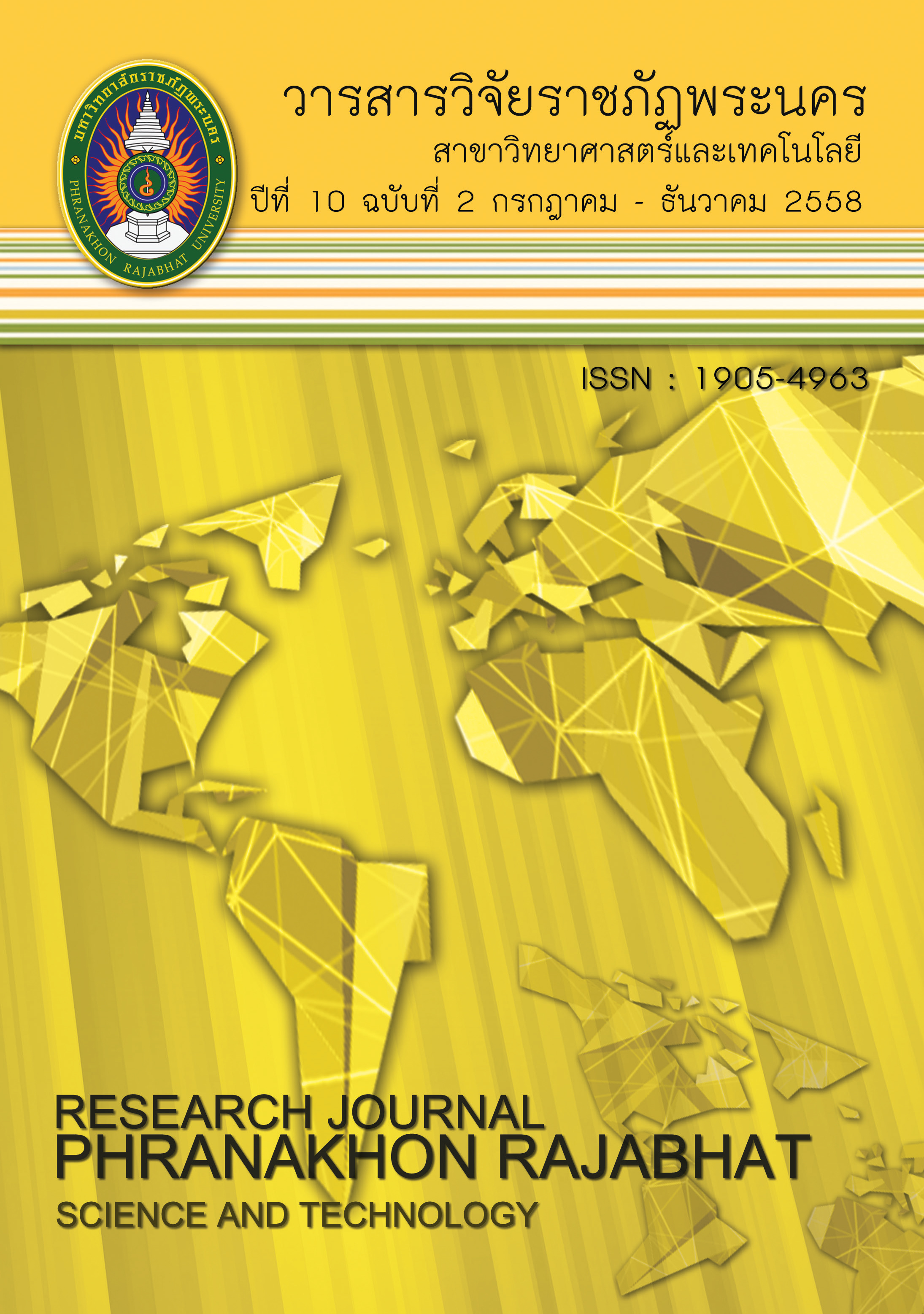การศึกษาการปนเปื้อนของสารกำจัดศัตรูพืชสู่สิ่งแวดล้อมในวิทยาลัยชัยบาดาลพิพัฒน์
Keywords:
การปนเปื้อน, สารกำจัดวัชพืช, สิ่งแวดล้อม, วิทยาลัยชัยบาดาลพิพัฒน์, Contamination, Pesticide, Environment, Chaibadalphiphat CollegeAbstract
วิทยาลัยชัยบาดาลพิพัฒน์ได้จัดตั้งขึ้นโดยมหาวิทยาลัยราชภัฏพระนคร เพื่อสร้างโมเดลการศึกษาเป็นแหล่งเรียนรู้ให้กับชุมชน โดยส่งเสริมให้เกิดการเปลี่ยนพื้นที่เป็นแบบเกษตรอินทรีย์แต่จากปัญหาการใช้เกษตรเคมีของพื้นที่โดยรอบ ซึ่งอาจส่งผลให้มีการตกค้างและปนเปื้อนของสารกำจัดศัตรูพืชภายในพื้นที่เกษตรสาธิตของวิทยาลัย งานวิจัยนี้จึงมีวัตถุประสงค์ 1) เพื่อสำรวจเก็บข้อมูลชนิดและวิธีการใช้สารกำจัดศัตรูพืชจากเกษตรกรรอบพื้นที่วิทยาลัย 2) เพื่อสำรวจชนิดและวิเคราะห์ปริมาณสารกำจัดศัตรูพืชที่ปนเปื้อนสู่สิ่งแวดล้อมในวิทยาลัย โดยสัมภาษณ์เกษตรกรรอบพื้นที่และใกล้เคียงแบบหยั่งลึก และเปิดโอกาสให้แสดงความคิดเห็นอย่างเต็มที่ นำข้อมูลที่ได้ทั้งหมดมาตีความข้อมูล อธิบายและสรุปเป็นผลการวิเคราะห์ข้อมูลเชิงคุณภาพ งานวิจัยนี้สุ่มเก็บตัวอย่างทั้งสามฤดูในพื้นที่วิทยาลัยและตรวจวิเคราะห์สารกำจัดศัตรูพืชทั้งหมด 59 ชนิด ในตัวอย่างนํ้า ตะกอน ดิน ผักบุ้งและผักกระเฉด ผลการวิจัยพบว่า เกษตรกรที่มีพื้นที่เพาะปลูกอยู่บริเวณรอบพื้นที่วิทยาลัยชัยบาดาลพิพัฒน์ส่วนใหญ่ปลูกอ้อย มันสำปะหลัง ข้าว และข้าวโพด ศัตรูพืชส่วนใหญ่เป็นวัชพืช ดังนั้นเกษตรกรจึงใช้สารกำจัดวัชพืชที่เหมือนกัน ได้แก่ ametryn paraquat และ atrazine วิธีการใช้ส่วนใหญ่ใช้ตามอัตราส่วนบนฉลาก และฉีดพ่น 2-3 ครั้งต่อปี โดยเกษตรกรจะฉีดพ่นยากำจัดวัชพืชก่อนทำการเพาะปลูกและในช่วงฤดูฝนที่วัชพืชเจริญเติบโตได้ดี ผลการวิเคราะห์หาชนิดและปริมาณสารกำจัดศัตรูพืชภายในวิทยาลัยพบสารกำจัดวัชพืชในตัวอย่างนํ้า 2 ชนิด คือ ametryn และatrazine ซึ่งปริมาณ ametryn ตรวจพบในฤดูฝน ในตัวอย่างนํ้า 3 ตัวอย่าง ในช่วง 0.01-0.03μg/l และ atrazine ตรวจพบทั้งสามฤดู ในตัวอย่างนํ้า 10 ตัวอย่าง ในช่วง 0.14-0.82 μg/l ซึ่งปริมาณ atrazine ที่ตรวจพบมีค่าตํ่ากว่าเกณฑ์ค่าสูงสุดที่ยอมให้มีการปนเปื้อนของ atrazineในนํ้าดื่มของ US.EPA (2003) (ไม่เกิน 3 μg/l) จากการตรวจพบ atrazine และ ametryn ในตัวอย่างนํ้าภายในพื้นที่วิทยาลัยที่ไม่ได้ใช้สารกำจัดวัชพืช จึงเป็นไปได้ที่จะเกิดการเคลื่อนย้ายatrazine และ ametryn จากพื้นที่เพาะปลูกรอบ ๆ ที่มีการใช้สารดังกล่าวลงสู่พื้นที่ของวิทยาลัยที่มีความลาดตํ่ากว่าบริเวณรอบ ๆ จากผลการวิจัยตรวจไม่พบสารกำจัดวัชพืชในตัวอย่างดินและตะกอน ทั้งนี้พื้นที่วิทยาลัยส่วนใหญ่เป็นดินร่วนปนทราย โดย atrazine จะถูกดูดซับในดินเหนียมากกว่าดินร่วนเหนียวปนทรายและดินร่วนปนทราย สำหรับในผักบุ้งและผักกระเฉดนั้นตรวจไม่พบสารกำจัดวัชพืช เนื่องจากปริมาณสารที่ตรวจพบในตัวอย่างนํ้าไม่ได้สูงมากจนทำให้เกิดการสะสมในพืชนํ้าบริเวณนั้นได้ แต่หากเกษตรกรยังคงใช้สารเคมีกำจัดวัชพืชอย่างต่อเนื่องและเพิ่มปริมาณการใช้ต่อไปโอกาสที่จะทำให้เกิดการสะสมและตกค้างในสิ่งแวดล้อมของวิทยาลัยอาจจะเกิดขึ้นได้โดยเฉพาะนํ้าบาดาลหรือนํ้าใต้ดิน ซึ่งงานวิจัยนี้ตรวจพบการปนเปื้อนสารกำจัดวัชพืชในนํ้ากรองที่สูบมาจากบ่อนํ้าบาดาลในฤดูฝน ดังนี้ ametryn 0.01 μg/l และ atrazine 0.27 μg/l และฤดูหนาวตรวจพบสาร atrazine 0.26 μg/l จึงแสดงให้เห็นว่ามีการปนเปื้อนของสารกำจัดวัชพืชทั้งสองชนิดลงสู่นํ้าใต้ดิน ดังนั้นเพื่อความปลอดภัยควรนำข้อมูลที่ได้มาเผยแพร่ให้คำแนะนำแก่เกษตรกร เพื่อนำไปสู่การเปลี่ยนแปลงวิถีการทำเกษตรกรรมจากการใช้สารเคมีมาเป็นการทำเกษตรอินทรีย์อย่างยั่งยืนที่เน้นการใช้อินทรียวัตถุ
Chaibadalphiphat College was a model established by Phranakhon Rajabhat University as a learning center for local community. This model promoted the usage of organic agriculture. One of remaining problems was that agricultural chemicals had still been used in the area of Chaibadalphiphat College, and this may cause contamination and possibly affects the environment of farmland demonstration of the college. The objectives of this research were 1) to collect data about types of pesticide and how to use them within the area of the college; 2) to study and deeply analyze types and amounts of pesticides that polluted agricultural areas and surrounding environment. Data were collected from the in-depth interview with farmers in the College and surrounding areas, and analyzed data by using qualitative methods. This research collected samples of 59 types of pesticide from water, sediment, soil, swamp morning glory (Ipomcea aquatic Forsk), and water mimosa (Neptumia oleracea Lour) from the areas in all three seasons. Farmers in Chaibadalphiphat College generally cultivated sugarcane, cassava, ice, and corn. The most common pest was weed. Farmers mostly used ametry, paraquat and atrazine. The amount of pesticide was based on labels on the containers, and were used 2-3 times per year. Farmers used pesticide before cultivating crops in rainy seasons which weed could grow well. Analysis of samples from water showed 2 types of pesticide, namely ametryn and atrazine. The amount of ametryn from 3 samples of water in rainy season were in 0.01-0.03 μg/l, and atrazine from 10 samples of water in all three seasons were in 0.14-0.82 μg/l. The amount of atrazine was lower than the highest rate of acceptable amount of this chemical that could be used in drinking water according to US.EPA (2003) (lower than 3 μg/l). From the investigation, atrazine and ametryn from water samples were collected in the area of Chaibadalphiphat College that did not use these chemicals. It was possible that these chemicals leaked from surrounding agricultural areas that sloped down to the College areas. From sediment and soil samples, there was no sign of contamination. The soil in the College was generally sandy loam. Atrazine, however, was absorbed better in clay more than in sandy loam. There was no contamination found in the samples of swamp morning glory and water mimosa. The amount of the chemicals in water was not outstandingly high, so they were not absorbed by water plants in the area. However, if farmers still used pesticides consecutively and increased its amount, it would cause greater impact on the environment around the College area, especially ground and underground water. From the samples of water that was collected from ground water in rainy season, they were contaminated with 0.01 μg/l of ametryn and 0.27 μg/l of atrazine, and the samples from winter season had 0.26 μg/l of atrazine. This suggested contamination of pesticide that affected underground water. The result of this research would be distributed to farmers and helped them adjusting to organic agriculture instead of using pesticides.
Downloads
Issue
Section
License
โปรดกรอกเอกสารและลงนาม "หนังสือรับรองให้ตีพิมพ์บทความในวารสารวิจัยมหาวิทยาลัยราชภัฏพระนคร สาขาวิทยาศาสตร์และเทคโนโลยี" ก่อนการตีพิมพ์




